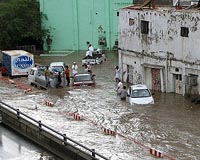| . |  |
. |
West Lafayette IN (SPX) Dec 23, 2009 A Purdue University scientist has shown man-made changes to the landscape have affected Indian monsoon rains, suggesting that land-use decisions play an important role in climate change. Monsoon rainfall has decreased over the last 50 years in rural areas where irrigation has been used to increase agriculture in northern India, said Dev Niyogi, an associate professor of agronomy and earth and atmospheric sciences. At the same time, heavily urban areas are seeing an increase in heavy rainfall. "In the rural areas, we're seeing premonsoon greening occurring two weeks earlier than what it did 20 years back as the demand for agricultural intensification to feed India's people increases," Niyogi said. "The landscape has also moved in some places from what was once a traditionally rural setting to large urban sprawls. Both of these phenomena have affected monsoon rains." Niyogi used more than 50 years of rainfall data - spanning back to 1951 - collected by 1,803 recording stations monitored by the India Meteorological Department to determine different regions' average yearly monsoon rain totals. While the mean monsoon rainfall for the entire country remained stable, Niyogi found that rainfall averages in India's northwest region decreased by 35 percent to 40 percent from the historical mean during the past 50 years. Analysis of soil moisture showed that before monsoon rains came, the northwest region had become as much as 300 percent wetter in recent years relative to the past 30 years, which has been attributed to irrigation from groundwater to sustain intensified agricultural production. This wetter surface causes cooling that weakens the strength of low pressure necessary for monsoons to progress into northern India. Satellite data showed that northern India is greening sooner than it had in the past. That greening is creating a barrier for monsoons, which provide much-needed rain to replenish groundwater reserves being used for irrigation. "In this case, you need a warm, dry surface to advance the monsoon," said Niyogi, whose findings were published in the journal Water Resources Research. "Because of increased irrigation, you now have a wet, green area, which does not allow the monsoon to reach far enough north." Since that rain isn't reaching the region, more irrigation is needed to sustain agriculture there. "Unless this is checked and controlled, the problem is going to become more and more severe," Niyogi said. "With more irrigation, we will have less monsoon rain. With less monsoon rain, you will need more irrigation, and the cycle will continue." Urban areas, on the other hand, are being pounded with rain when it comes. Niyogi said there have been storms in some urban areas that drop as much as 37 inches of rainfall in a single day. Analysis of the areas that have received increases in heavy seasonal rainfall, based on Indian Meteorological Department and NASA satellite data, showed that those areas were experiencing fast urban growth. Areas where seasonal rainfall decreased were determined to have slow or no urban growth. "You only see these types of heavy rainfall events in those areas with heavy urbanization," said Niyogi, whose research on the urban effect was published in the International Journal of Climatology. "The more urbanization spreads in those areas, the more of these heavy rain issues we'll see and the more flooding will become a problem." Niyogi said there are two theories on why that's happening. The first says that urban landscapes create heat, which extends into the atmosphere and energizes storms. The second theory is that pollution created in urban settings interacts with passing clouds and increases rainfall. Niyogi said the results of his study could have land-use implications elsewhere. "If urbanization is affecting the Indian monsoon season, it has the ability to affect patterns here in the United States," he said. "This likely isn't localized in India." He added that India is hotter than the United States, and that may be exacerbating the issues. As global temperatures rise, other parts of the world could see similar climate changes - if they aren't already - based on how land is used and developed. Chandra Kishtawal, of the Space Applications Center of the Indian Space Research Organization and a co-author on the papers, said he hopes the findings trigger discussions on the role of large-scale land-use planning in regulating climate change in India. "These kinds of things are not sustainable," Kishtawal said. "They cannot continue in the long run." The next step in this research is to examine landscapes in the United States to see if development has affected weather patterns historically. The National Science Foundation CAREER program and NASA's terrestrial hydrology program funded Niyogi's study. Share This Article With Planet Earth
Related Links Purdue University Water News - Science, Technology and Politics
 Huge sewage lake threatens flood-hit Jeddah
Huge sewage lake threatens flood-hit JeddahJeddah, Saudi Arabia (AFP) Dec 17, 2009 Weeks after a devastating flash flood, residents of Jeddah fear that further heavy rainfall could bring a huge, brimming reservoir of raw sewage cascading onto Saudi Arabia's Red Sea capital. Until the November 25 flood submerged homes and roads, killing at least 120 people, every day a line of tanker trucks made their way from Jeddah, a city of 2.6 million with almost no municipal sewerage ... read more |
|
| The content herein, unless otherwise known to be public domain, are Copyright 1995-2009 - SpaceDaily. AFP and UPI Wire Stories are copyright Agence France-Presse and United Press International. ESA Portal Reports are copyright European Space Agency. All NASA sourced material is public domain. Additional copyrights may apply in whole or part to other bona fide parties. Advertising does not imply endorsement,agreement or approval of any opinions, statements or information provided by SpaceDaily on any Web page published or hosted by SpaceDaily. Privacy Statement |